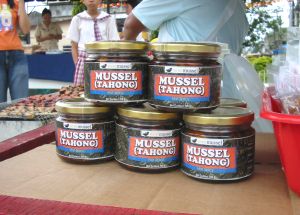Samar mussel industry
welcomes its godfather
By NINFA B. QUIRANTE (PIA
Samar)
April 12, 2007
 CATBALOGAN, Samar –
Tahong (mussel) and Mariculture godfather GiL Adora graced the
First Samar Mussel Industry Development Forum at the Cocina de Cabral
Wednesday, April 11, 2007.
CATBALOGAN, Samar –
Tahong (mussel) and Mariculture godfather GiL Adora graced the
First Samar Mussel Industry Development Forum at the Cocina de Cabral
Wednesday, April 11, 2007.
Adora, who is now the
Assistant Director for Technical Services at the Bureau of Fisheries
and Aquatic Resources (BFAR) Central Office impressed upon the people
how much he devoted his time and expertise to push the mussel industry
forward.
According to BFAR
Regional Director Ernesto Hilvano, Adora started the industry while
still a junior marine biologist. He along with someone surnamed
Mariano started studying the Maqueda Bay waters and started
propagating mussels.
The very same
livelihood has sustained poor mussel farmers in the municipalities of Jiabong,
Villareal, Tarangnan, Talalora, Motiong, Catbalogan, Zumarraga and
Daram.
Hilvano added that the
industry has been enjoying large growth through the years. He cited
that mussel farming started in 1975. In 1999 mussel production
throughout Samar yielded some 13,849 metric tons of mussels. Five
years later production soared in 2005 to 109,471 metric tons. While
mussel production declined as a whole in the country, in Samar
production has soared to a rough estimate of 790%.
Adora told the
participants that Samar-Leyte is strategically located and can supply
demands from both Luzon and Mindanao.
When PIA asked where
the first mussel could have originated, Adora said it could have come
from international ships that docked in our harbors. While docked, the
ship’s crew stripped off the rust and shells from the imbedded part
and along with these could have been the first mussels or tahong.
The first mussels were flown in from Parañaque, Adora said, these must
have come from Spain, he assumed.
Meanwhile, to solve
some of the problems that beset the mussel industry, Adora urged the
tahong farmers to manage their farms well.
He urged the
organizers to call on the newly elected LGU officials to orient them
on the rudiments of mussel production and that enabling laws be
drafted to ensure safety nets of the industry. He said that he would
also suggest ordinances to regulate the harvest of the mussels so that
a steady supply of the commodity can be assured.
As for the farmers, he
requested them to observe Red Tide Advisories and make sure these are
not violated. If a mussel farmer ignores Red Tide Warning and the
mussels he sells kill, Samar tahong will forever be doomed,
said Adora.
Apart from this, the
marine biologist also urged the mussel farmers to observe sanitation,
never to transport mussels in trucks loading hogs.
He gave them
recommendations to be observed to make sure that tahong
production soars to benefit poor farmers in Samar.